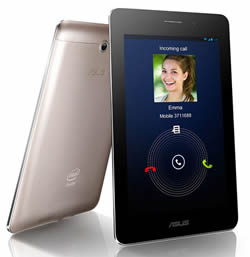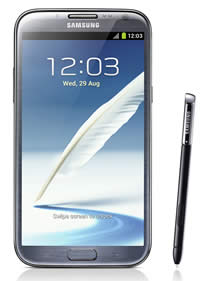Difference between Asus FonePad and Samsung Galaxy Note II
Key Difference: Asus has announced the launch of newest phablet, the Asus Fonepad. The Fonepad is a 7-inch Android tablet that allows users to also make phone calls by placing the device on their ear. The phablet sports a 7-inch IPS LED backlit touch screen that allowed multitouch capability for up to 10 people. The screen has a resolution of 1280 x 800, which provides approximately 216 ppi density, a decent enough resolution. The Samsung Galaxy Note II is a smartphone manufactured by Samsung and is an Android based device. The Note II is known for its large display of 5.5 inches (141 mm), as well as its integral use of a stylus, called the S pen. The beauty of a Galaxy Note II is that it falls between the categories of a smartphone and a tablet. It is hence marketed as a ‘phablet’, a phone and a tablet, a hybrid or sorts.
 Asus has announced the launch of newest phablet, the Asus Fonepad. The company states that the purpose of launching this phone is to bridge the gap between the phone and the tablet, eliminating the need for the carrying to separate devices. The Asus Fonepad is practically a tablet that has phone call making capabilities. The Fonepad is a 7-inch Android tablet that allows users to also make phone calls by placing the device on their ear. Some people may find it silly to place such a huge device on their ear to make calls; for those people the tablet does allow connectivity with a Bluetooth device.
Asus has announced the launch of newest phablet, the Asus Fonepad. The company states that the purpose of launching this phone is to bridge the gap between the phone and the tablet, eliminating the need for the carrying to separate devices. The Asus Fonepad is practically a tablet that has phone call making capabilities. The Fonepad is a 7-inch Android tablet that allows users to also make phone calls by placing the device on their ear. Some people may find it silly to place such a huge device on their ear to make calls; for those people the tablet does allow connectivity with a Bluetooth device.
The Asus Fonepad has borrowed a bunch of features from the Nexus 7, which was also created under Google and Asus collaboration. The weight, dimension and the display are all similar to the Nexus 7; however, the company has replaced the back. The plastic-leather back of the Nexus 7 has been replaced with a slick, steel casing. The device is available in titanium gray and champagne gold colors. The phablet sports a 7-inch IPS LED backlit touch screen that allowed multitouch capability for up to 10 people. The screen has a resolution of 1280 x 800, which provides approximately 216 ppi density, a decent enough resolution. Under the hood, the phablet runs on 1.2 GHz single-core Intel Atom processor, making it pretty fast for multi-tasking, along with playing some high-res games. The device has 1 GB RAM.
There will be two versions of the tablet, one for Europe, the other for Asia. The launch regarding rest of the World has yet to be revealed. The European variant will have 16 GB internal storage capacity, with no rear camera. However, the Asian variant will 8 GB internal storage capacity and will house a 3.2 MP rear camera. Both the variants will house 1.2 MP front camera for video conferencing. The phablet will not support 4G capabilities. The phablet will be available with preloaded Android v4.1 Jelly Bean, with no announcements yet regarding if it is upgradeable to the newest version. The internal storage capacity can expanded up to 32 GB using a MicroSD. One of the most prominent features of the phablet is the massive battery that has been mounted on the device. The non-removable Li-Ion 4270 mAh battery allows the phone to support 32.5 hours of talktime on 3G and 751 hours of standby time. There is no proper release date for the phone, with the expected release to be around April or May 2013.
 Samsung Group is a South Korean chaebol, the largest in South Korea. A chaebol is basically a conglomerate. Samsung Electronics has become one of the key competitors in the smartphone market due to innovative technologies. The group has launched popular phones such as Samsung Galaxy S3 and Galaxy Note II.
Samsung Group is a South Korean chaebol, the largest in South Korea. A chaebol is basically a conglomerate. Samsung Electronics has become one of the key competitors in the smartphone market due to innovative technologies. The group has launched popular phones such as Samsung Galaxy S3 and Galaxy Note II.
The Samsung Galaxy Note II is a smartphone manufactured by Samsung and is an Android based device. The Note II is known for its large display of 5.5 inches (141 mm), as well as its integral use of a stylus, called the S pen. The beauty of a Galaxy Note II is that it falls between the categories of a smartphone and a tablet. It is hence marketed as a ‘phablet’, a phone and a tablet, a hybrid or sorts.
In terms of hardware, the Note II features a 1.6 GHz quad-core processor, 720p resolution display, and 2 GB of RAM. The Note II is available in a variety of colors and in storage capacities of 16 GB, 32 GB and 64 GB. The phone also has an external expandable memory of up to 64 GB. The Galaxy Note II was launched with Android 4.1 (also called Jelly Bean) and at the time of its launch was the first phone to feature Android 4.1. Now, the phone is upgradeable to Android 4.1.2.
The information for the detailed table about the two phones has been taken from the Asus website, trustedreviews.com, pcworld.idg.com.au, Samsung website and GSMArena.com.
|
|
Asus Fonepad |
Samsung Galaxy Note II |
|
Launch Date |
Expected April 2013 |
September 2012 |
|
Company |
Asus |
Samsung Electronics |
|
Size |
196.4 x 120.1 x 10.4 mm |
151.1 x 80.5 x 9.4 mm (5.95 x 3.17 x 0.37 in) |
|
Display |
7" LED Backlight WXGA IPS Panel touch screen |
5.5 inches, super AMOLED capacitive touchscreen, 16M colors |
|
Screen |
1280x800 (~216 ppi pixel density) |
720 x 1280 pixels, (~267 ppi pixel density) |
|
Protection |
N/A |
Corning Gorilla Glass 2 |
|
Weight |
340 g |
183 g (6.46 oz) |
|
2G Network |
GSM 850 / 900 / 1800 / 1900 |
GSM 850 / 900 / 1800 / 1900 |
|
3G Network |
WCDMA: 850/900/1900/2100 HSDPA 850 / 900 / 1900 / 2100 |
HSDPA 850 / 900 / 1900 / 2100 HSDPA 850 / 900 / 2100 - N7105 |
|
4G Network |
N/A |
LTE 800 / 900 / 1800 / 2600 - N7105 |
|
GUI |
Asus UI |
TouchWiz UI |
|
CPU speed |
1.2 GHz Single-core Intel Atom |
Quad-core 1.6 GHz Cortex-A9 |
|
GPU |
PowerVR SGX540 |
Mali-400MP |
|
OS |
Android OS v4.1 (Jelly Bean) |
Android OS, v4.1.1 (Jelly Bean), upgradeable to 4.1.2 (Jelly Bean) |
|
Chipset |
Intel Atom Z2420 |
Exynos 4412 Quad |
|
RAM |
1 GB |
2 GB RAM |
|
SIM Size |
microSIM |
Micro-SIM |
|
Internal Memory |
8/16 GB |
16/32/64 GB |
|
Expandable Memory |
Up to 32 GB |
up to 64 GB |
|
Sensors |
GPS & Glonass,G-Sensor, E-compass, Proximity, Ambient Light Sensor |
Accelerometer, gyro, proximity, compass, barometer |
|
Connectivity |
GSM, HSDPA, WCDMA, Bluetooth, USB, WLAN802.11 |
Bluetooth v 4.0 (Apt-X Codec support) LE, USB 2.0 Host, WiFi 802.11 a/b/g/n (2.4 & 5 GHz), Wi-Fi HT40, Wi-Fi Direct, NFC, S Beam, Samsung AllShare Play & Control, Samsung AllShare Cast (WiFi Display), Mirroring & Extention, Samsung AllShare Framework |
|
Data |
GPRS, EDGE, WLAN, Bluetooth, USB |
WiFi, NFC, GPRS, EDGE, LTE (4G), USB |
|
Speed |
HSDPA 21 Mbps, HSUPA 5.76 Mbps |
HSDPA, 42 Mbps; HSUPA, 5.76 Mbps; LTE, Cat3, 50 Mbps UL, 100 Mbps DL |
|
WLAN |
WLAN802.11 b/g/n |
Wi-Fi 802.11 a/b/g/n, dual-band, DLNA, Wi-Fi Direct, Wi-Fi hotspot |
|
Bluetooth |
Bluetooth V3.0 |
Bluetooth v4.0 with A2DP, LE, EDR |
|
USB |
microUSB v2.0 |
microUSB v2.0 (MHL), USB Host |
|
Primary Camera |
3.2 MP autofocus camera |
8 MP, 3264x2448 pixels, autofocus, LED flash |
|
Secondary Camera |
1.2 MP |
1.9 MP |
|
Video |
720p |
1080p@30fps |
|
Camera Features |
Autofocus |
Simultaneous HD video and image recording, geo-tagging, touch focus, face and smile detection, image stabilization |
|
Sound Enhancement |
Active noise cancellation with dedicated mic; Asus Sonice Master audio technology with MaxxAudio 3 by Waves |
SNS integration Active noise cancellation with dedicated mic |
|
Audio supported formats |
MP3/WAV/eAAC+ player |
MP3/WAV/eAAC+/AC3/FLAC player |
|
Video supported formats |
MP4/H.264/H.263 player |
MP4/DivX/XviD/WMV/H.264/H.263 player |
|
Battery Capacity |
Non-removable Li-Ion 4270 mAh battery (16 Wh) |
Li-ion 3,100 mAh |
|
Talktime |
3G: 32.5 hours |
2G: 35 hours 3G: 16 hours |
|
Standby Time |
3G: 751 hours |
2G: 980 hours 3G: 890 hours |
|
Available Colors |
Titanium Gray, Champagne Gold |
Titanium Gray, Marble White, Amber Brown, Ruby Wine, Pink |
|
Messaging |
SMS(threaded view), MMS, Email, Push Email, IM |
SMS(threaded view), MMS, Email, Push Mail, IM, RSS |
|
Browser |
HTML5 |
HTML5 |
|
Radio |
No |
Stereo FM radio with RDS (N7100 only) |
|
GPS |
GPS, A-GPS, Glonass |
with A-GPS support and GLONASS |
|
Java |
Yes, via Java MIDP emulator |
Java MIDP emulator |
|
Additional Features |
|
|
Image Courtesy: asus.com, samsung.com









Add new comment